
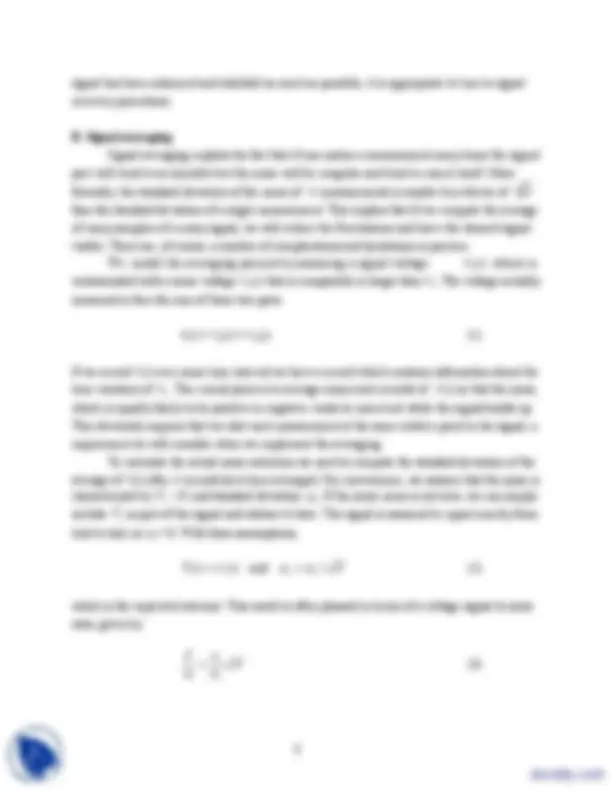
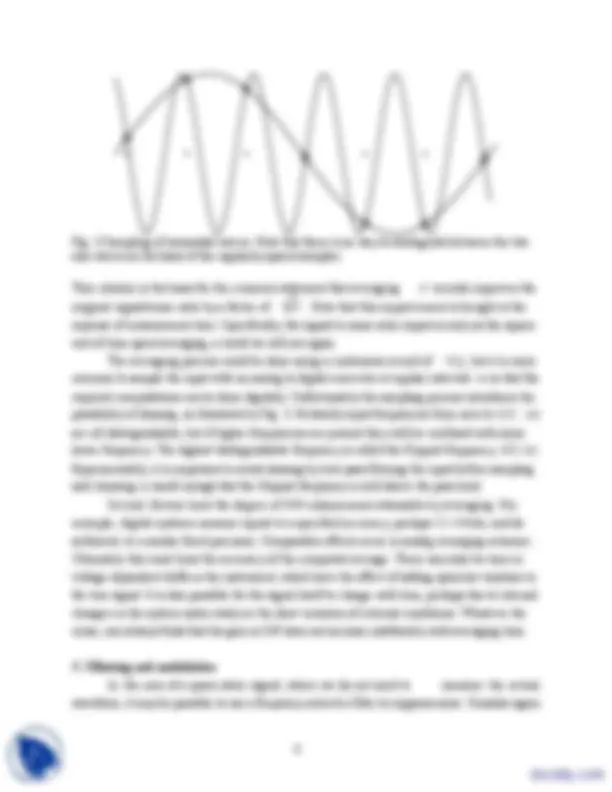
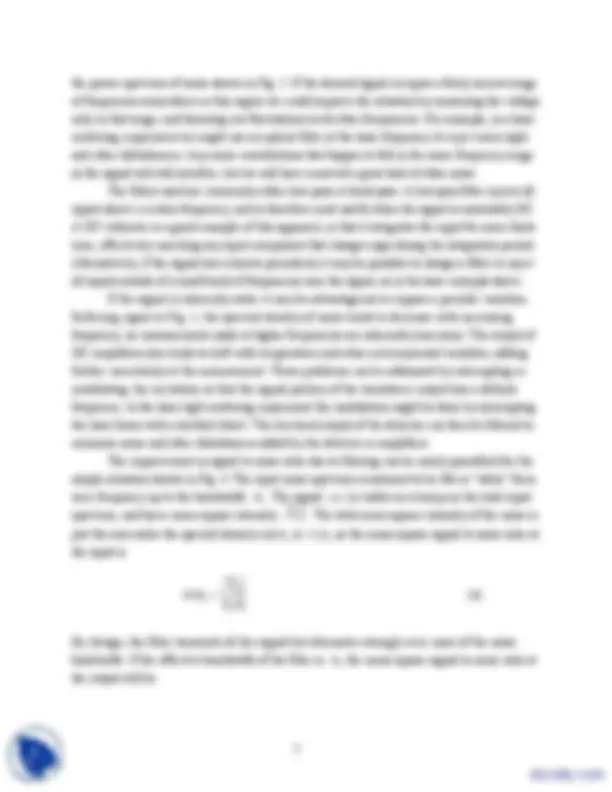
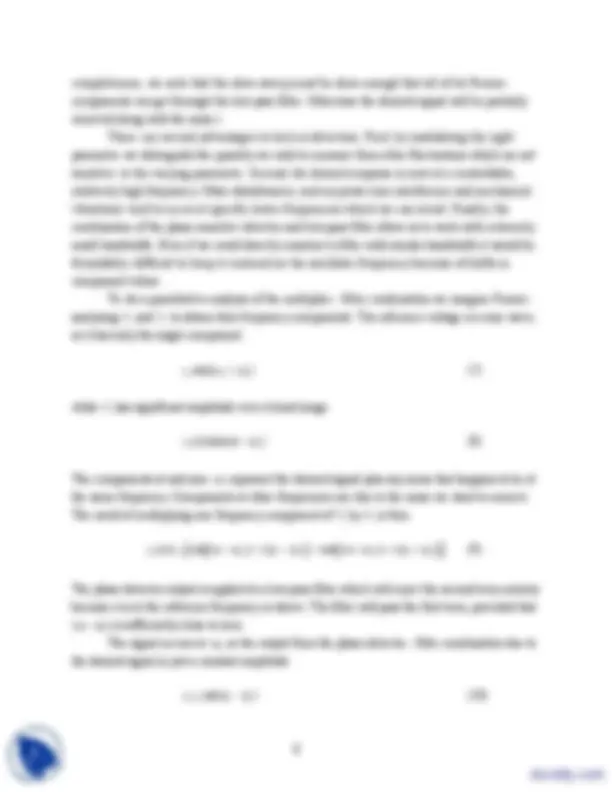
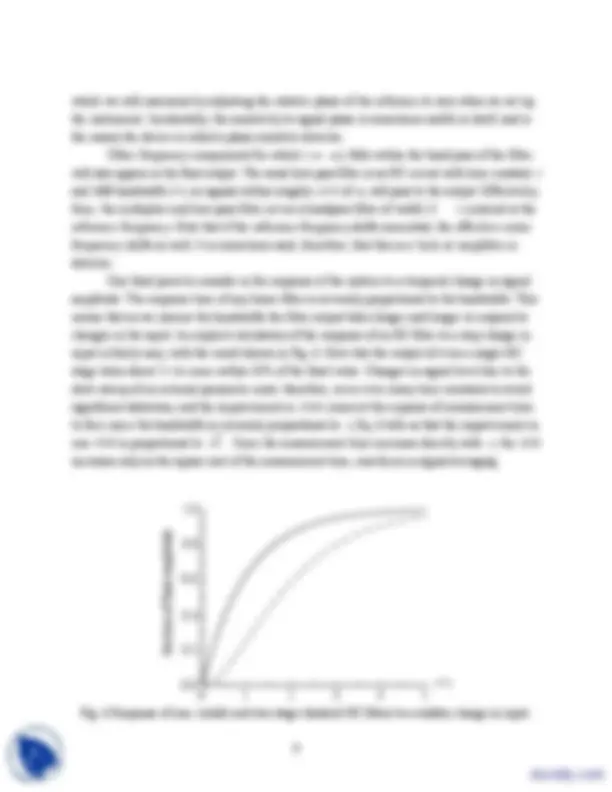




Study with the several resources on Docsity

Earn points by helping other students or get them with a premium plan


Prepare for your exams
Study with the several resources on Docsity

Earn points to download
Earn points by helping other students or get them with a premium plan
Community
Ask the community for help and clear up your study doubts
Discover the best universities in your country according to Docsity users
Free resources
Download our free guides on studying techniques, anxiety management strategies, and thesis advice from Docsity tutors
Insights into the challenges of measuring signals in the presence of noise and outlines various strategies for reducing noise in physics experiments. Topics covered include signal averaging, filtering, and lock-in detection. The document also includes a schematic spectrum of noise and interference and explanations of different types of noise, such as white noise, flicker noise, and thermal noise.
Typology: Study notes
1 / 13

This page cannot be seen from the preview
Don't miss anything!








Junior Physics Laboratory
When setting out to make a measurement one often finds that the signal, the quantity we want to see, is masked by noise, which is anything that interferes with seeing the signal. Maximizing the signal and minimizing the effects of noise then become the goals of the experimenter. To reach these goals we must understand the nature of the signal, the possible sources of noise and the possible strategies for extracting the desired quantity from a noisy environment.. Figure 1 shows a very generalized experimental situation. The system could be electrical, mechanical or biological, and includes all important environmental variables such as temperature, pressure or magnetic field. The excitation is what evokes the response we wish to measure. It might be an applied voltage, a light beam or a mechanical vibration, depending on the situation. The system response to the excitation, along with some noise, is converted to a measurable form by a transducer, which may add further noise. The transducer could be something as simple as a mechanical pointer to register deflection, but in modern practice it almost always converts the system response to an electrical signal for recording and analysis. In some experiments it is essential to recover the full time variation of the response, for example the time-dependent fluorescence due to excitation of a chemical reaction with a short laser pulse. It is then necessary to record the transducer output as a function of time, perhaps repetitively, and process the output to extract the signal of interest while minimizing noise contributions. Signal averaging works well when the process can be repeated, and we will examine the method in some detail. Alternatively, the signal of interest may be essentially static. Consider, for example, measuring the optical absorption of a beam of light traversing a liquid as a function of temperature or optical frequency. Any time variation is under the experimenter's control and does not convey additional information, so it is only necessary to extract the essentially steady signal from whatever noise is present. For this situation, drifts and instabilities in the transducer are often important, along with noise introduced in the experimental system. The usual strategies to deal with this combination of problems include chopping, filtering and, ultimately, lock-in detection, all of which we will consider.
Experimental system
Excitation Response
Signal Transducer + noise
Fig 1. Schematic of a generalized experiment.
A. Sources and characteristics of noise Noise can be roughly categorized as follows: "Interference" is at a definite frequency. Examples would be 60 Hz fields from power lines, high frequency fields from nearby radio or TV transmitters, and scattered laser light in an optics set up. Broad band, or "white noise" is more or less uniform over a wide range of frequencies. It can arise from multiple sources which blend together to give a uniform appearance, or, ultimately and inevitably, from the thermal vibrations of the apparatus. "Flicker" or "1/f noise" is a broad band noise that increases with decreasing frequency. It is quite commonly observed, but the level depends on the system. For example, all electrical resistors of the same value exhibit the same level of white noise but the additional 1/f contribution depends on the material. The overall situation is summarized in Fig. 2, which shows a typical noise spectrum and some interference sources. (The appendix to these notes includes a brief discussion of power spectra.) The type of noise afflicting the measurement, as well as the measurement requirements, will suggest an appropriate strategy. First one should attempt to strengthen the signal, if possible. This might involve using a stronger optical source, larger telescope, bigger force or whatever else might be possible and appropriate. After that one can try to reduce external interference by putting the apparatus in a metal box to block high frequency disturbances, by proper grounding to minimize power-line pickup, by cleaning lenses to reduce scattered light, and so on. Once the
10 -4^10 -2^10 0 10 2 10 4 10 6 10
10 0
10 1
10 2
10 3
10 4
10 5
10 6
Spectral density (arbitrary units)
Frequency (Hz)
'hum'
'ripple' transformer harmonics
power-lineinterferences
region offlicker and burst noise
white noise level 1/f noise
am/fm broadcast
TV andradar
computer power supplies
region of thermal and shot noise
contact arcing
mechanical vibration
temperature variations
Fig. 2 Schematic spectrum of noise and interference.
This relation is the basis for the common statement that averaging N records improves the original signal/noise ratio by a factor of N. Note that this improvement is bought at the expense of measurement time. Specifically, the signal to noise ratio improves only as the square root of time spent averaging, a result we will see again. The averaging process could be done using a continuous record of V ( t ), but it is more common to sample the input with an analog to digital converter at regular intervals ∆ t so that the required computations can be done digitally. Unfortunately the sampling process introduces the possibility of aliasing, as illustrated in Fig. 3. Evidently input frequencies from zero to 1/(2∆ t ) are all distinguishable, but if higher frequencies are present they will be confused with some lower frequency. The highest distinguishable frequency is called the Nyquist frequency, 1/(2∆ t ). Experimentally, it is important to avoid aliasing by low-pass filtering the input before sampling and choosing ∆ t small enough that the Nyquist frequency is well above the pass limit. Several factors limit the degree of S/N enhancement attainable by averaging. For example, digital systems measure inputs to a specified accuracy, perhaps 12-14 bits, and do arithmetic to a similar fixed precision. Comparable effects occur in analog averaging schemes. Ultimately this must limit the accuracy of the computed average. There may also be time or voltage-dependent drifts in the instrument, which have the effect of adding spurious variation to the true signal. It is also possible for the signal itself to change with time, perhaps due to internal changes in the system under study or the slow variation of external conditions. Whatever the cause, one always finds that the gain in S/N does not increase indefinitely with averaging time.
C. Filtering and modulation In the case of a quasi-static signal, where we do not need to measure the actual waveform, it may be possible to use a frequency-selective filter to suppress noise. Consider again
Fig. 3 Sampling of sinusoidal waves. Note that there is no way to distinguish between the two sine waves on the basis of the regularly-spaced samples.
the power spectrum of noise shown in Fig. 2. If the desired signal occupies a fairly narrow range of frequencies somewhere in this region we could improve the situation by measuring the voltage only in that range, and throwing out fluctuations at all other frequencies. For example, in a laser scattering experiment we might use an optical filter at the laser frequency to reject room light and other disturbances. Any noise contributions that happen to fall in the same frequency range as the signal will still interfere, but we will have removed a great deal of other noise. The filters used are commonly either low-pass or band-pass. A low-pass filter rejects all inputs above a certain frequency, and is therefore most useful when the signal is essentially DC. A DC voltmeter is a good example of this approach, in that it integrates the input for some finite time, effectively canceling any input component that changes sign during the integration period. Alternatively, if the signal has a known periodicity it may be possible to design a filter to reject all inputs outside of a small band of frequencies near the signal, as in the laser example above. If the signal is inherently static it may be advantageous to impose a periodic variation. Referring again to Fig. 2, the spectral density of noise tends to decrease with increasing frequency, so measurements made at higher frequencies are inherently less noisy. The output of DC amplifiers also tends to drift with temperature and other environmental variables, adding further uncertainty to the measurement. These problems can be addressed by interrupting or modulating the excitation so that the signal portion of the transducer output has a definite frequency. In the laser light scattering experiment the modulation might be done by interrupting the laser beam with a toothed wheel. The electrical output of the detector can then be filtered to minimize noise and other disturbances added by the detector or amplifiers. The improvement in signal to noise ratio due to filtering can be easily quantified for the simple situation shown in Fig. 4. The input noise spectrum is assumed to be flat or "white" from zero frequency up to the bandwidth B (^) I. The signal s(t) is visible as a bump on the total input spectrum, and has a mean-square intensity s^2 ( ) t. The total mean-square intensity of the noise is just the area under the spectral density curve, or P (^) NB (^) I , so the mean-square signal to noise ratio at the input is
SNR s^ t I P BN I
By design, the filter transmits all the signal but attenuates strongly over most of the noise bandwidth. If the effective bandwidth of the filter is B (^) O the mean-square signal to noise ratio at the output will be
sources. We then insert some sort of filter, most commonly electronic, before our measuring apparatus to pass the signal frequency range and block other frequencies. The lock-in detector is a particularly ingenious implementation of these principles because it allows us to create a very narrow-band filter which will automatically follow small changes in modulating frequency. The basic principle behind the lock-in detector is shown in Fig. 5. The experimental system is our apparatus and sample, as before. We want to measure some property of this system as a function of an external parameter like temperature or magnetic field which we can slowly 'sweep' over a desired range. An external oscillator is used to modulate a system parameter in such a way that the quantity we wish to measure varies at frequency ω r. This could be the same parameter that is being varied slowly, such as the wavelength of the incident light in our optics example, or an independent parameter such as the intensity of the light. The object in either case is to impose a variation at ω r on the desired signal, without modulating the noise that you want to eliminate. The response of the system is converted to a varying voltage with an appropriate transducer and applied to the phase detector as V (^) s , which includes noise from the experiment and transducer. The phase detector multiplies this voltage by a reference voltage Vr at frequency ω r , producing a product voltage V (^) r V (^) s. Now comes the crucial point: The desired signal and the reference voltage are at the same frequency and are always in phase, so a Fourier analysis of their product contains a constant term. Other inputs, like noise, will be at different frequencies and phases. Fourier analysis of their products will disclose time-varying components, but almost no DC part. The multiplier voltage is filtered by the low-pass circuit, which passes the DC signal voltage but suppresses the time-varying noise voltages to yield the final output V (^) o. (For
Experimental system
Sweep
Oscillator ω (^) r
Pre-amp
Phase shifter
Filter
Sensitivity
Transducer
Low-passfilter Output
Time constant
Reference channel
Signal channel
Vr
Vs
Fig. 5 Block diagram of a phase-sensitive detection system connected to an experiment.
completeness, we note that the slow sweep must be slow enough that all of its Fourier components can get through the low pass filter. Otherwise the desired signal will be partially removed along with the noise.) There are several advantages to lock-in detection. First, by modulating the right parameter we distinguish the quantity we wish to measure from other fluctuations which are not sensitive to the varying parameter. Second, the desired response is now at a controllable, relatively high frequency. Other disturbances, such as power line interference and mechanical vibrations tend to occur at specific lower frequencies which we can avoid. Finally, the combination of the phase sensitive detector and low-pass filter allow us to work with extremely small bandwidth. Even if we could directly construct a filter with similar bandwidth it would be formidably difficult to keep it centered on the oscillator frequency because of drifts in component values. To do a quantitative analysis of the multiplier - filter combination we imagine Fourier analyzing V (^) s and V (^) r to obtain their frequency components. The reference voltage is a sine wave, so it has only the single component
v (^) r sin( ω (^) r t + φ r ) (7)
while V (^) s has significant amplitude over a broad range
v (^) s ( ω )sin(ω t + φ s ) (8)
The components at and near ω r represent the desired signal plus any noise that happens to be at the same frequency. Components at other frequencies are due to the noise we want to remove. The result of multiplying one frequency component of V (^) s by V (^) r is then
v (^) s ( ω ) v (^) r {cos ( [ ω − ω r (^) ) t + (φ (^) i (^) −φ r (^) ) (^) ] − cos ([ ω + ω r (^) ) t + (φ (^) i (^) +φ r )]} (9)
The phase detector output is applied to a low pass filter which will reject the second term entirely because it is at the reference frequency or above. The filter will pass the first term, provided that ( ω - ω r ) is sufficiently close to zero. The signal occurs at ω r , so the output from the phase detector - filter combination due to the desired signal is just a constant amplitude
v vi r cos( φ i (^) − φ r ) (10)
E. Appendices
V t dt
T 2 2 0
∫ ( )^ (11)
where the average runs over either one full cycle or over a long time if the voltage is irregular. The quantity V^2 is called the mean square voltage, with units of volts squared, and is exactly half of A^2 for a sine wave. It is easy to show that the average power dissipated by the voltage V(t) in a resistor R is just V^2 R , further reinforcing the idea that this is an intensity. The square root of V^2 has units of volts, and is called the root mean square or rms voltage. This quantity is useful because it sometimes behaves like a voltage in circuit calculations but is not limited to sine waves.
F( ω) = V t e i ω^ tdt T
T ( ) /
/
−
∫ 2
2 (12)
is useful for that purpose. To avoid issues of convergence, the integral here runs over some long but finite time. Like the set of Fourier series coefficients, the complex function F(ω) gives the amplitudes and phases of the sine waves at frequencies ω which will add up to the original signal. We are usually interested only in intensity information, not phase, so we can employ the magnitude-squared of the transform
( ω ) = lim ( ω) →∞
where P( ω ) is called the power spectral density of the signal, with units of volts^2 /Hz. For real- valued V(t) , the only case of physical interest, P( ω ) is a an even function of ω, so all the physical information is contained in the positive frequency domain. Integrating P( ω ) over all frequencies, we recover the mean-square voltage
V^2 P d 0
∞
further reinforcing the connection to intensity. More physically, the power part of the name comes again from the proportionality to voltage squared, and it is a spectral density because it is the voltage squared per unit frequency interval. Effectively, P( ω ) tells us how much power our signal has at a specified frequency. This information is particularly useful when considering the action of circuits which selectively attenuate or amplify certain frequency bands.
o i (^) Z R C C
where Z (^) C = 1/ i ω C. In practice we usually need only the amplitude ratio, which is
V V
o i
1 2 ( ) / ωτ
where τ = RC is the time constant of the circuit. This ratio is plotted in Fig. 8. The low-pass
Vi C Vo
Vi C
C (^) Vo
Fig. 7 One and two-stage RC filter circuits. A unity gain amplifier prevents the second stage from loading the first stage.
Both of these relations have been plotted in Fig. 6. Comparing Figs. 6 and 7, we see that the improvement in high-frequency rejection with the two-stage filter has been obtained at the cost of much longer response time. The application will determine which factor is more important.